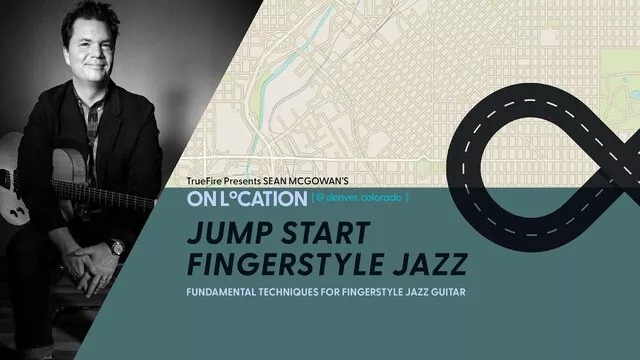Truefire Sean McGowan’s On Location: Jump Start Fingerstyle Jazz TUTORIAL
Fundamental Techniques for Fingerstyle Jazz Guitar
In order to become a solid fingerstyle jazz player you have to develop a well-rounded variety of left and right hand techniques, harmonic concepts, and rhythmic approaches — which, for most of us, is a process of continuous long-term growth.
Sean McGowan designed this Jump Start Fingerstyle Jazz edition of On Location for newer fingerstyle jazz players. The course contains the concepts and approaches that a player needs to start playing fingerstyle jazz quickly and efficiently.
”I’ve organized the course into six distinct sections. Each section will feature a “Learn and Practice” lesson, which features several concepts that are key components of fingerstyle jazz guitar. Each lesson is followed by an overview, performance, and detailed breakdown and analysis of a full-length étude to play.
In the first section, we’ll examine how to plot out notes for a walking four bass line, using diatonic scale tone and chromatic approaches. Then we’ll learn how to bring a bass line to life using essential techniques such as skips with the picking hand and pull-offs with the fretting hand. We’ll also learn a dynamic octave triplet figure pattern that jazz bassists frequently use to propel the progression forward. Then we’ll put these techniques to use over a Bb blues progression based on Miles Davis’s “Freddie Freeloader” called, “Walkin’ and Skippin’”.
The second section will feature exercises designed to develop a strong fingerstyle foundation using pinch, and 2-, 3-, and 4-finger claw techniques. We’ll learn how to play with and against the thumb, creating independence to incorporate chord jabs over a moving bass line. Then we’ll work through another blues progression in Bb (“Freeloadin’ Fun”) that gradually integrates these fingerstyle techniques, building chords one note at a time while articulating a walking four bass line.
In the next section, we’ll continue working on jazz rhythms and articulation by focusing on the fretting hand. We’ll learn the ‘bounce’ technique, which is essential to creating a three-dimensional sound, plus planting and developing independence with each of the fingers of the fretting hand. We’ll check out the concepts of short (staccato) and long (legato) chord jabs, and how to play constantly moving ‘four to the bar’ chords in the style of legendary guitarist Freddie Green. Then we’ll play through several choruses of a blues progression in a Kansas City jump style that features the bounce technique in action over riff-like bass lines.
Section Four explores the bass and chord comping options over tunes in 3/4 time. We’ll learn and practice ‘quick jabs’ and how to incorporate open strings in your bass line to facilitate rapid position shifts. We’ll also learn a classic jazz waltz pattern and the floating concept to push and pull the time feel. We’ll put all of this together over a complex blues progression in 3/4 called, “Third Coast Blues”, based on Wes Montgomery’s classic “West Coast Blues”.
In Section Five, we’ll learn how to play and articulate a bass line with chords and percussion on a backbeat over a straight 8th note time feel. We’ll go over rapid shifts in chord fingerings and also how to transition from straight to swing feel in the style of great blues musicians such as Freddie King. Then we’ll apply all of this over a soulful Cm blues titled, “Ain’t No Thrill” (based on the perennial B.B. King favorite, “The Thrill is Gone”)
Finally, in Section Six we’ll put it all together: walking bass lines with articulations, full-bodied chord jabs, and classic harmonic substitutions. We’ll also learn some swinging triplet fills with chords against the bass, and left-hand chordal hammer-ons to spice things up. “The Gold Standard” is a 12-bar jazz blues progression that features complex chord subs and variations on familiar turnarounds and moves. The étude starts off with an articulated walking four bass, and gradually introduces more complex chords, turnarounds, and rhythmic moves to create the illusion of more than one player!”
Sean will explain and demonstrate all of the key concepts and approaches along the way. You’ll get standard notation and tabs for all of the performance studies. Plus, you’ll be able to use TrueFire’s learning tools to sync the tab and notation to the video lesson. You can also loop or slow down the videos so that you can work with the lessons at your own pace.
Grab your guitar, and let’s dig in with Sean McGowan!



